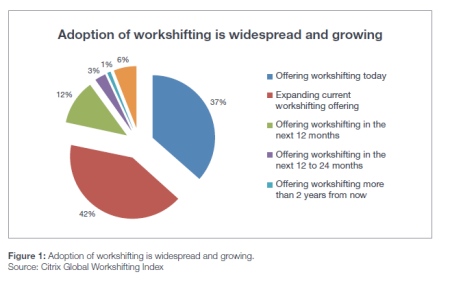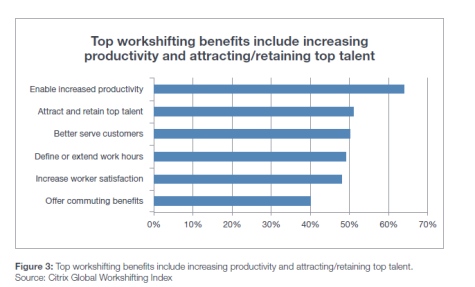Organizations are trying to build more flexible work environments, and they need help from channel partners with the technology that can make their workplace dreams a reality.
Vendor Citrix Systems Inc. (NASDAQ: CTXS) recently released the results of its Citrix Global Workshifting Index. Workshifting is a Citrix-coined term referring to creating flexible work practices in general. The survey results suggest that 93 per cent of organizations will be working to provide more flexible work environments for their employees in the next year, and some have already begun the process.
“We’re really looking at work as something we do,” not just a place we go, said Stacy Bruzek-Banerjee, director of product and solutions marketing at Citrix. That attitude is not unique to the vendor either, she argues.
In Canada, 64 per cent of organizations want to implement workshifting policies to reduce costs, including improved support for a mobile workforce. Three quarters of IT leaders surveyed were from organizations of more than 1,000 employees, with the remainder at companies between 500 and 1,000 employees.

“Everybody’s handling it differently,” Bruzek-Banerjee said. “Many companies are taking the cube walls down completely.” Reducing real estate costs and having desk sharing policies is one way to tackle mobile working, but the right technology has to be in place as well.
Trends such as bring your own device (BYOD) are driving mobile working initiatives. “In the past, remote work was for the few; it was the special exception,” she said. “Today, people have the power.”
Unsurprisingly, Citrix touts desktop virtualization as one major technology to aid in the shift. “You need to take a look at the devices out there; there’s a lot of them,” Bruzek-Banerjee said. “We help organizations deliver their existing applications to any device.”
Related story: Why desktop virtualization is a tool, not a strategy for taking on BYOD
According to its survey, 93 per cent of IT decision-makers also see desktop virtualization as a “very effective way to address business continuity.”
Among companies smaller than those included in the index, workshifting is still occurring, particularly for business continuity benefits, she said. Business continuity options have typically been difficult for SMBs to afford, but desktop virtualization is helping to change that.
Other technology apart from desktop virtualization, such as voice over IP phones and Web and video conferencing tools, can also help with the transition to more flexible working environments. For channel partners, the opportunity with workshifting is a major one if they can know how to have the right conversations with top level executives and demo the right options, she said.

Businesses clearly are interested in these kinds of policies, so the next step is showing how to do it. At Citrix, for example, partners receive marketing collateral such as whitepapers, and demo scripts to aid the conversation, she said.
The need for employee attraction and retention is also driving more flexible working policies, Citrix argues. Employee turnover at a company can cost potentially millions of dollars in recruitment and new training.
Follow Harmeet Singh on Twitter: @HarmeetCDN

